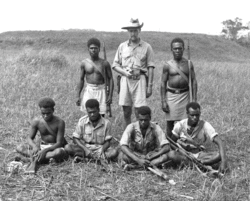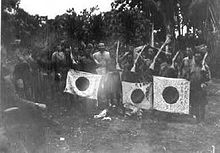
The Coastwatchers, also known as the Coast Watch Organisation, Combined Field Intelligence Service or Section C, Allied Intelligence Bureau, were Allied military intelligence operatives stationed on remote Pacific islands during World War II to observe enemy movements and rescue stranded Allied personnel. They played a significant role in the Pacific Ocean theatre and South West Pacific theatre, particularly as an early warning network during the Guadalcanal campaign.
Overview
Captain Chapman James Clare, district naval officer of Western Australia, proposed a coastwatching programme in 1919. In 1922, the Australian Commonwealth Naval Board directed the Naval Intelligence Division of the Royal Australian Navy to organise a coastwatching service. Walter Brooksbank, a civil assistant to the Director of Naval Intelligence, worked in the 1920s and 1930s to organise a skeleton service of plantation owners and managers whose properties were in strategic locations in northern Australia, the Australian controlled Territory of Papua and the British Solomon Islands. In 1939, when war appeared imminent, he expanded the coast-watching service with additional island planters, traders, miners and missionaries. During the war the civilian coastwatchers were augmented with about 400 coastwatchers who were Australian military officers, New Zealand servicemen, Pacific Islanders, or escaped Allied prisoners of war.
Lieutenant Commander Eric Feldt, based in Townsville, Queensland, led the Australian coastwatching organisation during much of World War II. Coastwatchers became particularly important in monitoring Japanese activity in the roughly one thousand islands that make up the Solomon Islands. Commander Feldt resigned his command due to illness in March 1943. His role was taken over by James McManus of the Royal Australian Navy.
The Australian military commissioned many personnel who took part in coastwatcher operations behind enemy lines as officers of the Royal Australian Navy Volunteer Reserve (RANVR) to protect them in case of capture, although the Imperial Japanese Army did not always recognise this status, and executed several such officers. Escaped Allied personnel and even civilians augmented the coastwatchers' numbers. In one case, three German missionaries assisted the coastwatchers after escaping Japanese captivity, even though Nazi Germany had allied itself with the Empire of Japan during the war.
Feldt code-named his organisation "Ferdinand", taking the name from a popular children's book about a bull, The Story of Ferdinand. He explained this by saying:
Ferdinand ... did not fight but sat under a tree and just smelled the flowers. It was meant as a reminder to coastwatchers that it was not their duty to fight and so draw attention to themselves, but to sit circumspectly and unobtrusively, gathering information. Of course, like their titular prototype, they could fight if they were stung.
In June 1942 "Ferdinand" became part of the Allied Intelligence Bureau, which came under the Allies' South West Pacific Area (command) (SWPA). However Feldt reported both to GHQ, SWPA, in Brisbane and to the United States-Australian-British Fleet Radio Unit in Melbourne (FRUMEL), which came under the Pacific Ocean Areas command.
New Zealand developed its own coastwatching scheme from the 1930s. From the outbreak of war, the New Zealand Naval Board controlled coastwatching stations located around the New Zealand coastline and in the eastern Pacific. Stations were established in the Gilbert and Ellice Islands, Tokelau, Samoa, Fanning Island, the Cook Islands, Tonga, and Fiji.
Significance
| The coastwatchers saved Guadalcanal and Guadalcanal saved the South Pacific. |
| — U.S. Admiral William Halsey. |
When the Japanese overran the Gilbert Islands in 1942, 17 New Zealand coastwatchers were captured. Imprisoned at Tarawa, they were executed by the Japanese in October 1942 following an American air raid.
In early November 1942, two coastwatchers named Jack Read and Paul Mason on Bougainville Island radioed early warnings to the United States Navy about Japanese warship and air movements (citing the numbers, type, and speed of enemy units) preparing to attack the US Forces in the Solomon Islands.

K. H. McColl had to flee from Wuvulu Island when Japanese forces began searching the nearby island, and travelled with other coast watchers to the Sepik River. McColl and L. Pursehouse operated in 1942 and 1943 at an abandoned Lutheran mission at Sattelberg, New Guinea. The mission was situated atop a hill about 900 metres (3,000 ft) above sea level, approximately 8 kilometres (5.0 mi) inland from Finschhafen, and would later become a battle site from 17 and 25 November 1943 during the Battle of Sattelberg. McColl and Pursehouse were ambushed by Japanese forces, however they escaped. In December 1944 McColl was back in the Sepik River region.
One of the most highly decorated coastwatchers was Sergeant Major Sir Jacob C. Vouza, who retired from the local constabulary in 1941, volunteered for coastwatcher duty, and was captured and interrogated brutally. He survived and escaped to make contact with US Marines warning them of an impending Japanese attack. He recovered from his wounds and continued to scout for the Marines. He was awarded the Silver Star and Legion of Merit by the United States, and later received a knighthood as well as becoming a Member of the Order of the British Empire.

In 1943 Lt. (j.g.) John F. Kennedy of the United States Navy—a future president—and 10 fellow crew members were shipwrecked after the sinking of their boat, the PT-109. An Australian coastwatcher, Sub-Lt Arthur Reginald Evans, observed the explosion of the PT-109 when it was rammed by a Japanese destroyer. Despite US Navy crews giving up the downed crew as a complete loss, Evans dispatched Solomon Islander scouts Biuku Gasa and Eroni Kumana in a dugout canoe to search for survivors. The two scouts found the men after searching for five days. Lacking paper, Kennedy scratched a message on a coconut describing the plight and position of his crew; Gasa and Kumana then paddled 38 miles (61 km) through Japanese-held waters, at great personal risk, to deliver the message to Evans, who radioed the news to Kennedy's squadron commander. The future US president was rescued shortly afterward, and 20 years later welcomed Evans to the White House. Gasa did not make the trip, later claiming he received the invitation to attend but was fooled into not attending by British colonial officials. Gasa left his village and arrived in Honiara, but was not allowed to leave in time for the ceremony.
"After the rescue Kennedy said he would meet us again," Kumana says in The Search for Kennedy's PT-109. "When he became President, he invited us to visit him. But when we got to the airport, we were met by a clerk, who said we couldn't go—Biuku and I spoke no English. My feelings went for bad."
In July 2022, Coastwatchers James Burrowes and Ronald George Lee were still living, and were honoured in a wreath-laying ceremony by U.S. Ambassador to Australia Caroline Kennedy (daughter of President Kennedy) and General Mark Milley, Chairman of the U.S. Joint Chiefs of Staff.
In popular culture
There was an increase of interest in coastwatchers following the election of Kennedy to President in 1960. Coastwatcher characters appeared in films such as The Wackiest Ship in the Army and TV productions such as The Coastwatchers.
References
- Jones, David; Nunan, Peter (January 2005). U.S. Subs Down Under: Brisbane, 1942–1945. Naval Institute Press. p. 50. ISBN 978-1-59114-644-5.
- ^ White, Osmar (1 November 1957). "The Man in the Panama Who Mothered the Coastwatchers". XXVIII(4) Pacific Islands Monthly. Retrieved 1 October 2021.
- "A Light Flashes for the Men Who "Saved the Pacific"". XXX(2) Pacific Islands Monthly. 1 November 1957. Retrieved 2 October 2021.
- "The Coast Watchers". gunplot.net. Retrieved 28 April 2018.
- Lord, Walter (2012). Lonely Vigil: Coastwatchers of the Solomons (eBook ed.). Open Road. ISBN 9781453238493.
- "The Coastwatchers 1941–1945". Australia's War 1941–1945. Government of Australia. Archived from the original on 18 January 2009. Retrieved 2 September 2008.
- "Coast Watch Organisation or Combined Operational Intelligence Service Section "C" of the Allied Intelligence Bureau". Australia at War. Retrieved 2 September 2008.
- "Operation Watchtower: Assault on the Solomons" War in the Pacific: The First Year. U.S. National Park Service, 2004.
- "The Southern Gilberts occupied". nzetc.org. Retrieved 9 May 2018.
- Hardman, Reg; Sagers, Carmody (4 June 2009). "Behind Enemy Lines: An Amateur Radio Operator's Amazing Tale of Bravery". ARRL. Retrieved 3 May 2016.
- McColl, K. H. (18 March 1947). "Out of the End of a Limb!". XVII(8) Pacific Islands Monthly. Retrieved 29 September 2021.
- Freund, A. P. H. (16 December 1946). "Coast Watchers In New Guinea Jungles". XVII(5) Pacific Islands Monthly. Retrieved 29 September 2021.
- Freund, A. P. H. (8 February 1947). "Jap Dodging Behind Finschhafen". XVII(7) Pacific Islands Monthly. Retrieved 29 September 2021.
- McColl, K. H. (19 April 1947). "Trapped by Nips!". XVII(9) Pacific Islands Monthly. Retrieved 29 September 2021.
- McColl, K. H. (19 April 1947). "Out of the End of a Limb!". XVII(9) Pacific Islands Monthly. Retrieved 29 September 2021.
- Woo, Elaine (16 August 2014). "Eroni Kumana dies at 93; helped rescue JFK and his PT-109 crew". Los Angeles Times. Retrieved 23 June 2016.
- Chamberlain, Ted (20 November 2002). "JFK's PT-109 Found, U.S. Navy Confirms". National Geographic News. Archived from the original on 29 November 2002.
- "Ambassador Caroline Kennedy’s Meeting with Australian Coastwatchers at the Australian War Memorial ", U.S. Embassy & Consulates in Australia (28 July 2022)
- Vagg, Stephen (2023). "Forgotten Australian TV Plays: The Coastwatchers". Filmink. Retrieved 9 August 2024.
Sources
- Butcher, Mike (2012). ... when the long trick's over: Donald Kennedy in the Pacific. Kennington, Vic., Australia: Holland House. ISBN 9780987162700.
- Clemens, Martin (2004). Alone on Guadalcanal: A Coastwatcher's Story (reissue ed.). Bluejacket Books. ISBN 1-59114-124-9.
- Feldt, Eric Augustus (1991) . The Coastwatchers. Victoria, Australia: Penguin Books. ISBN 0-14-014926-0.
- Feuer, A. B. (1992). Coastwatching in World War II. Stackpole Military History Series. Westport, Connecticut, USA: Stackpole Books. ISBN 0-8117-3329-7.
- Horton, D. C. (1970). Fire Over the Islands. ISBN 0-589-07089-4.
- Lord, Walter (2006) . Lonely Vigil; Coastwatchers of the Solomons. New York: Naval Institute Press. ISBN 1-59114-466-3.
- Macdougal, A. (2002). Australians at War: A Pictorial History. The Five Mile Press. ISBN 1-86503-865-2.
- Rhoades, F. A. (1982). A Diary of a Coastwatcher in the Solomons. Fredericksburg, Texas, USA: Admiral Nimitz Foundation.
Further reading
- Perrin, Alex E. (1990). The Private War of the Spotters: A History of the New Guinea Air Warning Wireless Company February 1942 – April 1945. Foster, Victoria: NGAWW Publication Committee. ISBN 0731672925.
- Hall, D. O. W. (1951). Coastwatchers. New Zealand in the Second World War. Episodes & Studies. Vol. 2. Wellington, New Zealand: War History Branch, Department of Internal Affairs. OCLC 1022254.
- Shaw, Henry I. Jr. (1992). First Offensive: The Marine Campaign for Guadalcanal. Washington, D.C.: History and Museums Division, Headquarters, U.S. Marine Corps. ISBN 9780160379413.
{{cite book}}:|work=ignored (help)
External links
- Bowen, James. "Australian Coastwatchers in the Pacific War". A History of the Battle for Australia 1942–43. Archived from the original on 7 August 2007. Retrieved 12 December 2006.
- Dunn, Peter (2005). "Coast Watch Organization". Australia @ War. Retrieved 12 December 2006.
| Special Forces of Australia of the Australian Defence Force | |||
|---|---|---|---|
| Leadership | |||
| Australian Army |
| ||
| Royal Australian Navy |
| ||
| Royal Australian Air Force | |||
| Related | |||
| Historical units | |||